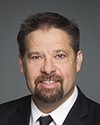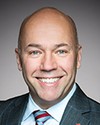Mahsi. Good day. I bring greetings from the Deh Gah Got'ie First Nation. We are part of the Dehcho First Nations in the Northwest Territories. I am honoured to be in this part of the country to honour also the Coast Salish territory as we are here today.
Respectfully, I offered tobacco to the grandmothers and grandfathers of this land outside of this hotel this morning for guidance for this committee in working on the youth and suicide issue.
I've been working for my community and people since I was 23 years of age. I attended 13 years of residential school in the Northwest Territories. Youth and suicide in our native community is a very serious issue. Knock on wood, we've had little pockets of suicide occasionally happening in our northern region thus far. I am quite aware of what has been happening in Lac la Ronge recently.
I want to focus my presentation to you today on the legacy and impact of residential schools on my community and the Dehcho region.
The Roman Catholic mission was first established in my community in the 1860s by the Grey Nuns, first as an orphanage, and then as Sacred Heart Mission school built in 1930. I attended there beginning when I was six years old, for about seven years; then I went on to Grollier Hall in Inuvik, Lapointe Hall in Fort Simpson, and Grandin College in Fort Smith. All that time we were taught the golden rules of “don't talk, don't trust, don't feel” in all the schools that I attended.
When brought to the mission school, you were basically abandoned by your parents and community, hoping that, in the name of God, you would be cared for. One of the biggest impacts and results of the residential school is that many of us did not have a clue about proper parenting. Hugs, kisses, and nurturing were foreign to us. In our community today you can barely see evidence of this nurturing that I want to speak to today.
Personally, I have suffered at least two, or maybe three, bouts of depression, which eventually will lead to suicidal thoughts and suicide. I've learned that “depression” is defined as anger turned inwards. Suicide is the result of spiritual wounding. In the residential school, you completely abandoned what you were just beginning to believe in. Then we were indoctrinated in Roman Catholic practices and doctrine.
It has been about 30 years now, and I and others have sobered up and have begun our journey of recovery and healing.
I am fortunate to have relearned my Dene language, and to have had an accelerated learning of Dene culture and beliefs over the past 20 years. I am very grateful to elders and my community for this.
Elders advise us that all of the solutions we're seeking are embodied in Mother Nature and on the land. On-the-land education is key for us and for our communities that are seeking recovery.
It is also critical that we have parenting workshops and training for young parents. What a child learns and experiences from zero to six years old is paramount.
The sense of belonging has to be restored in our community. Renewing Dene culture through workshops is so critical. It's a requirement.
We need to complete the residential school work that was started 16 years ago in our community. Some of my people who I work with have a question: are we prepared to deal with youth suicide in our community? Right now, the answer would be no. Do we have the resources and plan in our community? The answer is probably still no, but we're working like the dickens to get there.
Cross-cultural training for front-line workers, social workers, and mental health workers has to be mandatory, especially if they come to our community. This has to be implemented as soon as possible by all governments concerned.
We always believe that Dene culture, beliefs, and values are based on relationships. These have to be restored if we're going to get some kind of a foothold on how to address and begin searching for the solution that all of us in Canada are seeking.
Sometimes I share with some people the fact that over a year ago, on October 19, I voted for the first time in a long time in the federal election. That morning, before I went to the polling station, I told my wife that I would vote that day for healing to begin for all native communities and also for the rest of Canada. I wanted to share that with you as part of my presentation.
I also included in my document a brief history of my community, and also a second page outlining the typical characteristics of a residential school survivor.
Mahsi.




